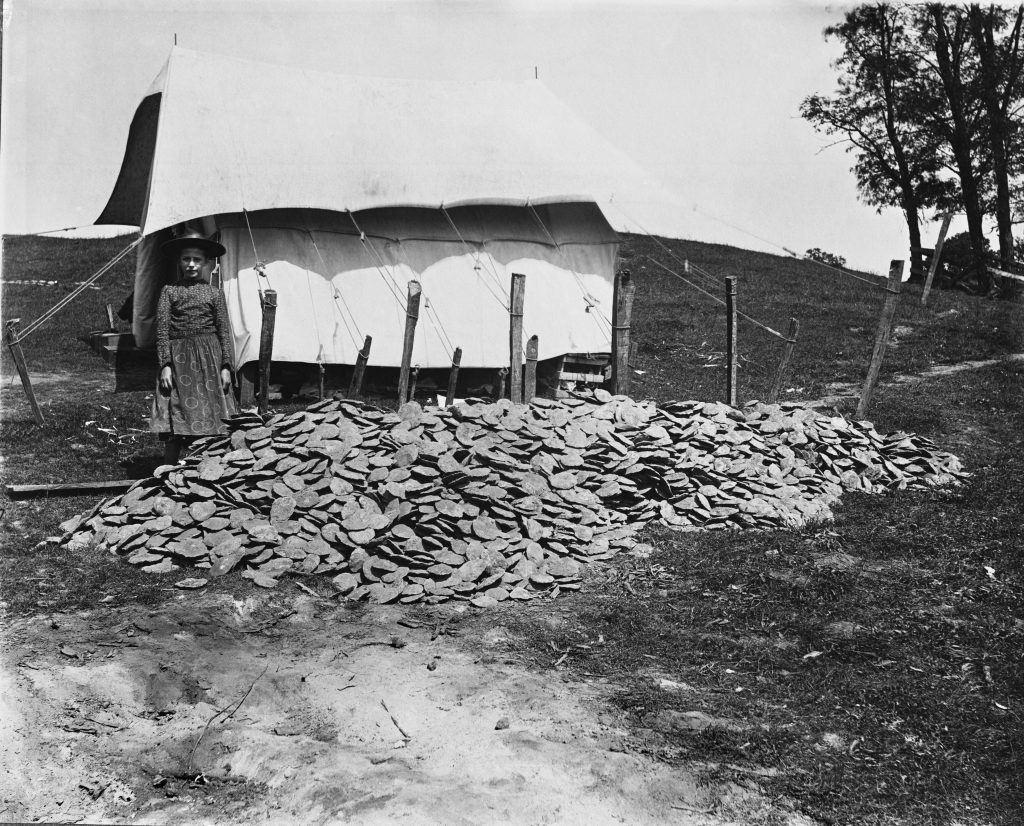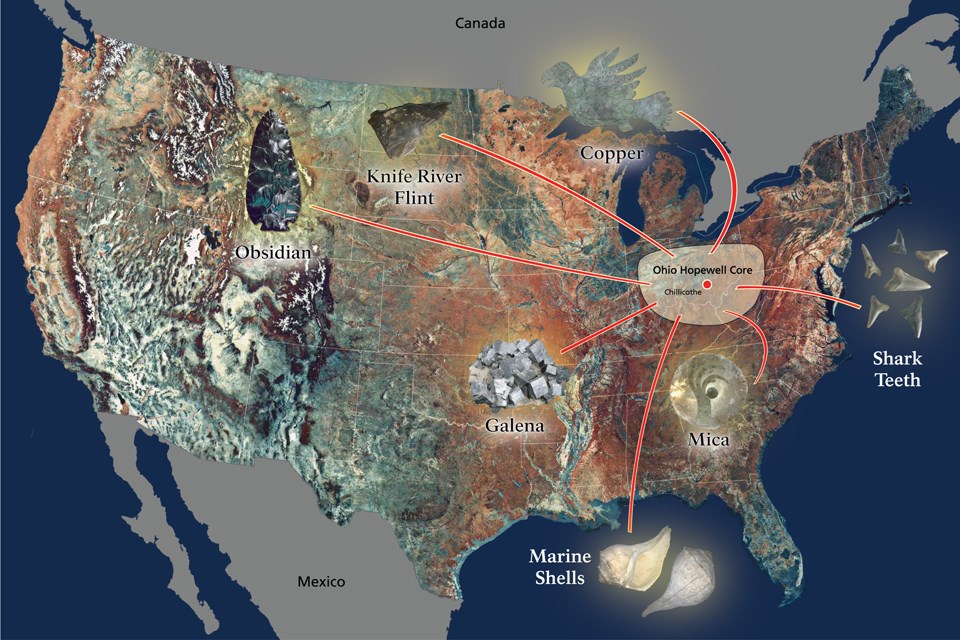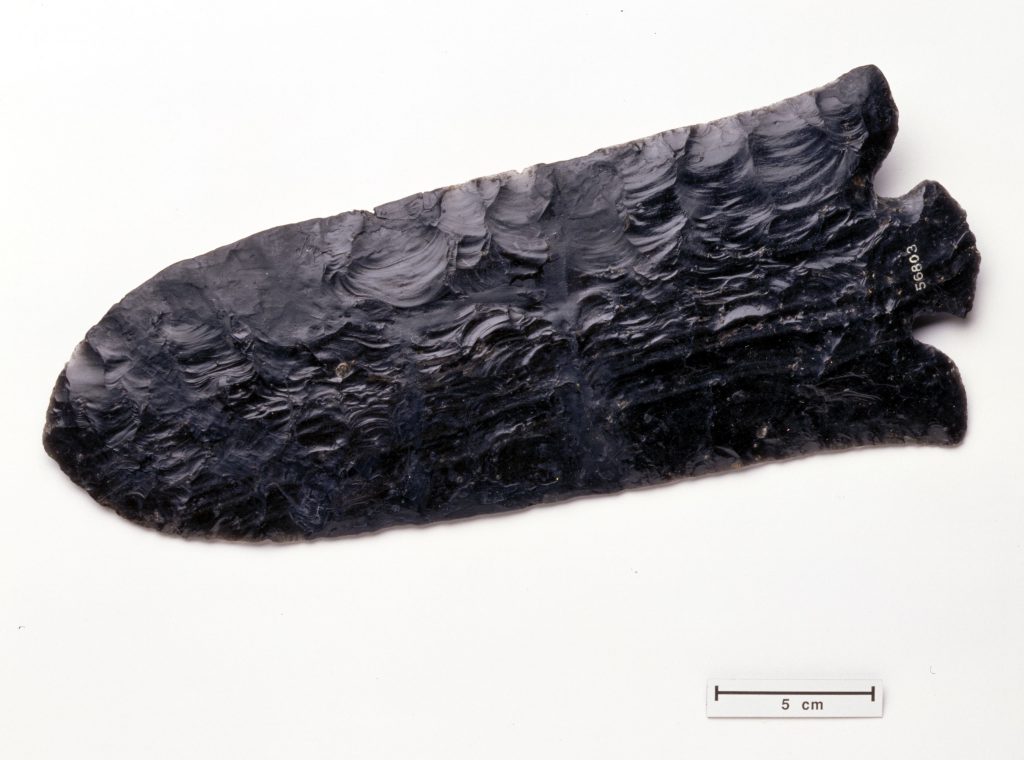Transcontinental Travel—2,000 Years Ago
Two thousand years ago, a sophisticated people lived in the rolling hills of the greater Mississippi River drainage in North America. Most of their sites are concentrated in what are today the fertile valleys of southern Ohio, Indiana, Illinois, and Missouri.
For roughly 500 years, between about 100 B.C. and A.D. 400, these people sustainably farmed corn, squash, and other plants. And they hunted deer, rabbit, and birds. They also fished the many rivers and lakes in the region, and almost certainly paddled rudimentary dugout canoes up and down various river systems.
When they weren’t producing food, these people built hundreds of burial mounds in the shape of cones and truncated pyramids. They also constructed hundreds of effigy mounds configured as birds, snakes, and other animals. Even more remarkable than the actual existence of these earthen monuments is the fact that people created them using digging sticks, baskets, and lots of human muscle power.
Those mounds held a wonderful secret: These ancient people loved beautiful objects and had a deeply held aesthetic. And what we know from their objects is that these folks also loved to travel—a lot—just like I do. Indeed, they must’ve journeyed all across North America, and that’s why I feel they are kindred spirits.
The most important early, professional archaeological study of these people occurred in 1891 and 1892 when Warren K. Moorehead excavated a fantastically rich archaeological site in southern Ohio, not far from Chillicothe. He called the site Hopewell, after the local landowner. Not long thereafter, archaeologists applied the Hopewell name to the entire pre-Columbian culture in the region.
In addition to finding hundreds of thousands of animal bones, pottery sherds, busted stone tools, and tool-manufacturing debris, Moorehead excavated unbelievable quantities of exotic artifacts and the raw materials out of which those artifacts were fashioned. He found thousands of sheets of broad, flat mica, a silicate mineral that can be cut and made into pendants, decorations, and mirrors. The Hopewell collected those mica sheets from what is now Tennessee and North Carolina, hundreds of miles to the south and southeast of the site.
Moorehead also unearthed approximately 7,000 fist-sized chipped-stone disks made of Wyandotte chert from southern Indiana, a couple hundred miles to the west. He recovered freshwater pearls from the Mississippi and Ohio rivers, and shark teeth that came from either the Gulf of Mexico or the southeast coast of the U.S. He excavated copper that was sourced from northern Michigan and galena, a dense lead mineral that naturally forms into cubes, from western Illinois, Iowa, and Wisconsin. And Moorehead uncovered hundreds of pounds of obsidian, or volcanic glass, that originally came from 1,500 miles away—in what is today Yellowstone National Park in Wyoming!
How did the Hopewell get all that material to what is now Ohio? There’s no way around the fact that humans collected it—and thus, those Hopewell collecting trips were largely made on foot, using human muscle power. These travelers didn’t have draft animals, horses to ride, or even wheels.
It’s possible that they used dugout canoes or wooden rafts to transport themselves and their collections along the many rivers of the mid-continent. But those craft would’ve still required human power to move. Unfortunately for archaeologists, wooden artifacts like rafts and canoes don’t preserve well in the damp archaeological sites of the Midwestern U.S. Although the absence of evidence isn’t necessarily evidence of absence, we are left to suppose that the Hopewell may have made and used watercraft—but we simply don’t know for sure.
But they could have traded for these raw materials, right? We don’t think so. Many of the areas from which the raw materials were collected, such as Yellowstone, were sparsely populated—there weren’t many people to trade with. There’s also no evidence of what the Hopewell would have given in exchange for such large quantities of raw material. Typically, when archaeologists identify evidence of past trade, there are strong indications of objects going in both directions—ceramics exchanged for obsidian, for example. We simply don’t find enough Hopewell goods scattered around North America for trade to be a viable explanation.
Some archaeologists have suggested the Hopewell sites were pilgrimage centers—that people came to the Ohio Valley for religious ceremonies, perhaps bearing raw materials as gifts or offerings. That’s possible, but this theory hangs up on the problem of scale. The Ohio sites just aren’t large and complex enough for the pilgrimage collecting theory to be plausible. And there is scant evidence that the Hopewell ceremonial systems were so centralized.
So what’s the likely explanation? The evidence strongly suggests the Hopewell made epic collecting trips. Archaeologists dryly refer to this phenomenon as the Hopewell Interaction Sphere. I eagerly call it amazing.
One of the most significant Hopewell discoveries, from my perspective, is a large obsidian blade. It’s a symmetrical beauty that measures 12 inches long and 5 inches wide. But it’s only about a quarter of an inch thick. It stuns modern flintknappers for the skill it represents: How did the ancient knapper manage to make it so thin across a 5-inch-wide cross-section? Few knappers today would attempt such a feat—fewer still would succeed.
What was that blade used for?
The answer is nothing, at least in strictly utilitarian terms. Flaked obsidian yields incredibly sharp edges, but those edges are delicate and brittle. If used to cut meat or scrape skins, obsidian tools require almost constant resharpening. The obsidian blade from Hopewell is so big that it’s effectively useless—it’d snap into a thousand pieces if you tried to cut or scrape anything with it.
It was almost certainly used for ceremonial or symbolic purposes, to illustrate the power of the person who held it in his or her hand. Indeed, that person may have been the one who had the political or religious power to send a team of people halfway across the continent, to Yellowstone, to collect the obsidian out of which it was made. It’s no simple feat to make the trip; it’s also no simple feat to convince others to do it for you. But someone brought that obsidian to Ohio.
I sometimes imagine being in a Hopewell village when a collecting group returns home from a months-long sojourn into the unknown. I would have loved to experience the joie de vivre, the esprit de corps, and the stories those travelers told. I can’t ignore the romance and wanderlust that must have driven them. While we may never know the real reason that all these wonderful artifacts and exotic raw materials ended up in Ohio, the fact that they are there makes me celebrate the wonders of our collective humanity.




























